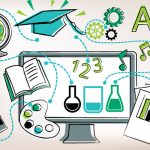Individuals today are continuously striving to find resources which can help them amplify their educational prospects and efficiency. The conventional methods are gradually losing their charm with the evolution of technology. To keep up with the demands of the students and the shift in their learning inclination, various resources have been introduced in the digital forum to make the learning process more exciting and conducive. The formerly registered barriers of time zone, defective teaching, and the budget constraints have been overcome to make the learning process more simplified and easy to access. Some of these sources are illustrated below:
- Digital Education Tool 1: Simulation and Models
Behold the most intriguing tool catered to us by technology. This tool has not only facilitated the students but has been beneficial for individuals belonging to various disciplines. The potential associated with the simulation is extremely high because it exceeds the student’s engagement level. The additional benefit of simulation is that it allows the expansion of the parameters of the leaning model. The students get to experience the similar condition and situations which allows them to test their learning capabilities in real time. The tools are valuable for the testing of the student’s critical thinking. These tools are basically used in aeronautical and medical disciplines.
- Digital Education Tool 2: Animations and Graphics
These digital tools break down the complication process into simple understandable parts which allow the students better nurturance. The animations and graphical representation of the concept have been noticed to have higher retention probability. It gives birth to a student’s positive and creative thinking. It breaks down the concept and creatively brings them together which makes learning fun and exciting as well as improves the retention rate of the students. The integration of the GIFs and the reactions and surprise moment assimilated in it allows the sharing of the knowledge and information in an effective and efficient manner. Furthermore, the visuals are recorded to be the best source of learning for the individuals.
- Digital Education Tool 3: Electronic textbooks
The traditional books are said to become extinct with the increasing time. The use of electronic textbooks has saved the institutes and the students alive form the hassle of updating their textbook in every curriculum. The attainment of the e-textbook is just one-time cost, as we don’t have to invest in a new book every time the content of the book gets updated or a new version comes out. Another added benefit of the book is that it reduces the storage space, no need to carry the gigantic burden of books when you can have all those installed in a single screen. The instant delivery of information, access to multimedia, Assignment help, and more has made the learning through it more convenient and exciting.
- Digital Education Tool 4: Games and Quizzes
You would be lying if you said gaming is not your jam. Regardless of the discipline or the nature of the course we study, games involvement has made the learning process more fun and engaging. Integration of games with the learning practices has made it more conducive and thrilling for the students. Students constantly seek opportunities where they get the opportunity to test their understanding through games and quizzes. Moreover, these games and quizzes can be altered according to the target audience and can be altered as per the situation.
These technologies are serving as the building blocks of the present learning processes. These resources have resulted in a paradigm shift which is projected to further boost in the years to come.












